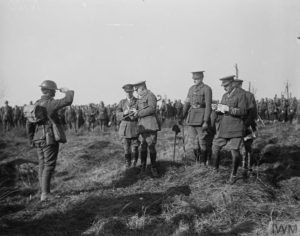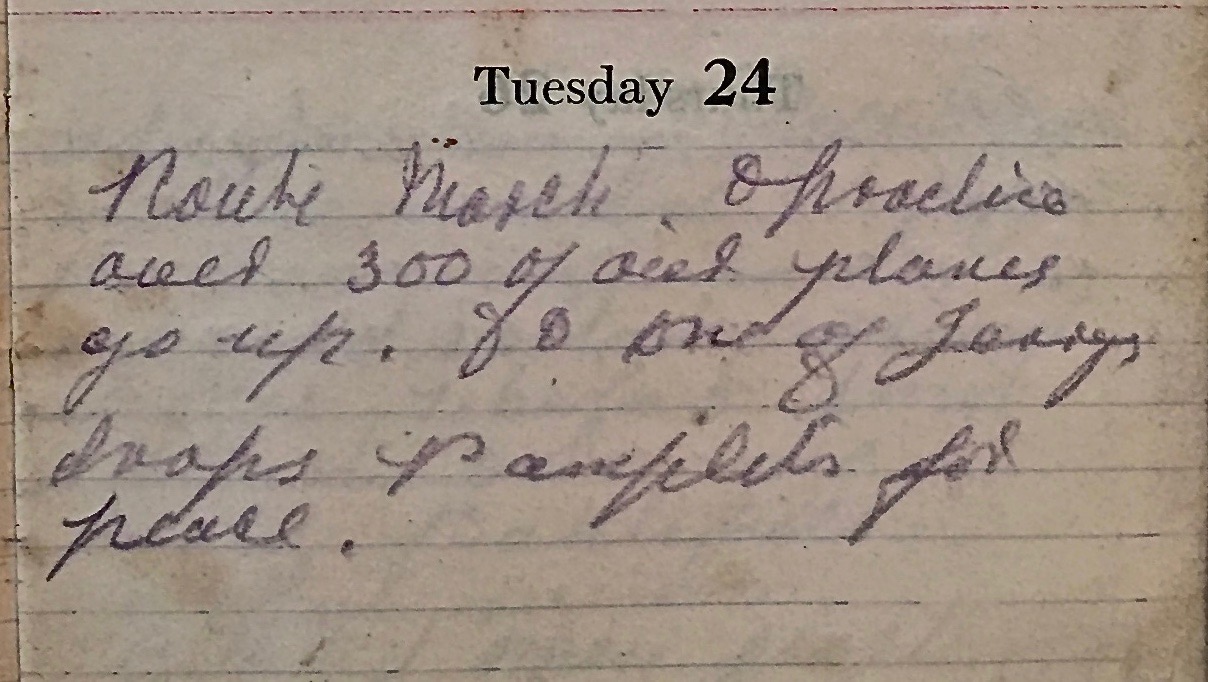Tuesday September 24th, 1918
Route march and practice. Over 300 of our planes go up. One of Jerry’s drops pamphlets for peace.
South African Overseas Expeditionary Force
On September 13th, the 1st South African Infantry Brigade joined the 199th Brigade of the 66th Division.
This was the infantry unit of the volunteer South African Overseas Expeditionary Force (SAOEF), formed in July 1915, to support the British war effort. With memories of the Boer War still raw, many South Africans had objected to the entry of their country into the war. Consequently the SAOEF was raised entirely by volunteers. Unlike other commonwealth forces, the SAOEF was integrated into, and under the operational command, of the British Army. It was funded directly by the British Government.
The SAOEF comprised:
- 1st South African Infantry Brigade comprising four Regiments. By mid-1918 only the 1st, 2nd and 4th were still constituted.
- Cape Corps, comprising two infantry battalions and a labour battalion
- Heavy Artillery Brigade comprising four siege batteries, attached to the Royal Garrison Artillery
- Field Artillery
- Horses
- Rifles
Other units comprised medics, vets, engineers, signals, supply and transport personnel and the SA Native Labour Corps.¹
1st South African Infantry Brigade

In February 1916, the Brigade saw action at the Battle of Agagia during the Senussi Campaign in Egypt. When the campaign ended successfully for the Allies, the South African Brigade, still under the command of the then Brigadier General Henry T Lukin, were sent to France.
In mid-1916, the Brigade, now part of the 9th (Scottish) Division, saw action on the Somme, most famously and desperately in Delville Wood. They retained Delville Wood, as instructed, from July 15th until they were relieved on July 20th. It was the most costly action for the South African Brigade – of the 3,153 men who entered the wood, only 780 were present at roll-call after their relief. The 3rd Regiment had been virtually wiped out – through death, injury or capture.²
Lukin was appointed GOC of the 9th Scottish Division with the rank of Major-General in late 1916 and knighted the following year. The photograph shows Lukin, with Brigadier-General PJ Dawson to his right, presenting decorations at the South African Brigade’s memorial service at Delville Wood in February 1918.*
The Brigade, still part of the 9th Scottish, again saw distinguished service and terrible losses in April 1918 at Moislain on the Lys during the German Offensive.†
This bloodied and heroic 1st South African Infantry Brigade, now under the command of Brigadier-General PJ Dawson, has joined the 199th ‘to refit’.†
Pamphlets
Both Frank and the Battalion’s Diary mention that hundreds of pamphlets have been dropped by the enemy. They are clearly mirroring Allied propaganda tactics. Unfortunately, despite being referenced, the actual pamphlet is not in the War Diary for September 1918.
9th Battalion War Diary – 24th September 1918 – Manin
Enemy planes passed over at about 7am and dropped hundreds of pamphlets (Appendix No 6) they covered a large area of country around this village.
All companies practiced the attack in the forenoon. In the afternoon the CO, 2nd in command, Adjutant and Coy Commanders assembled at Brigade HQ and afterwards practiced on the ground the Brigade scheme which will take place on 26th inst. 4 OR are struck off the effective strength after 7 days in hospital 24-9-18.
References & Further Reading
¹ South African Overseas Expeditionary Force on Wikipedia
² 1st Infantry Brigade (South African) on Wikipedia
³ Senussi Campaign on Wikipedia
† ‘General Jack’s Diary, War on the Western Front 1914-1918’ edited by John Terraine, Cassell, 2003, originally published 1964, page 263/4
* Q 10674, copyright Imperial War Museums


